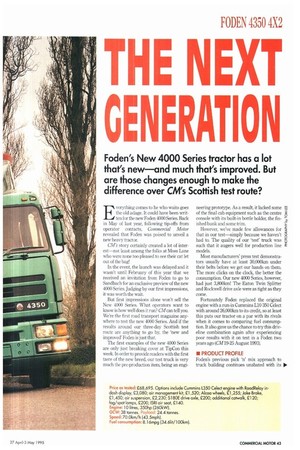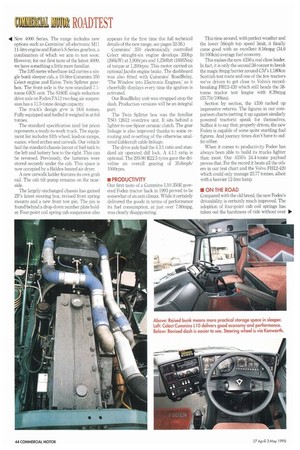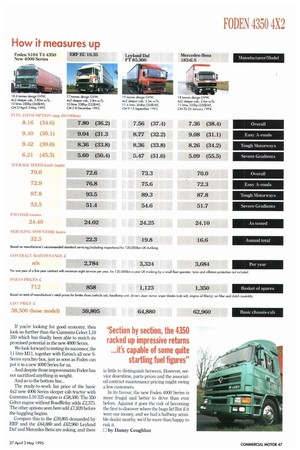NERATION
Page 45

Page 46

Page 48

Page 49

If you've noticed an error in this article please click here to report it so we can fix it.
Foden's New 4000 Series tractor has a lot that's new—and much that's improved. But are those changes enough to make the
difference over CM's Scottish test route?
Everything comes to he who waits goes the old adage. It could have been written for the new Foden 4000 Series. Back in May of last year, following tip-offs from operator contacts, Commercial Motor revealed that Foden was poised to unveil a new heavy tractor.
CM's story certainly created a lot of interest—not least among the folks at Moss Lane who were none too pleased to see their cat let out of the bag!
In the event, the launch was delayed and it wasn't until February of this year that we received an invitation from Foden to go to Sandbach for an exclusive preview of the new 4000 Series. Judging by our first impressions, it was worth the wait.
But first impressions alone won't sell the New 4000 Series. What operators want to know is how well does it run? CM can tell you. We're the first road transport magazine anywhere to test the new 4000 Series. And if the results around our three-day Scottish test route arc anything to go by, the 'new and improved' Foden is just that.
The first examples of the new 4000 Series are only just breaking cover at TipCon this week. In order to provide readers with the first taste of the new breed, our test truck is very much the pre-production item, being an engi
neering prototype. As a result, it lacked some of the final cab equipment such as the centre console with its built-in bottle holder, the finished bunk and some trim.
However, we've made few allowances for that in our test—simply because we haven't had to. The quality of our 'test' truck was such that it augers well for production fine models.
Most manufacturers' press test demonstrators usually have at least 30,000km under their belts before we get our hands on them. The more clicks on the clock, the better the consumption. Our new 4000 Series, however, had just 3,800km! The Eaton Twin Splitter and Rockwell drive axle were as tight as they come.
Fortunately Foden replaced the original engine with a run-in Cummins L10 350 Celect with around 26,000km to its credit, so at least this puts our tractor on a par with its rivals when it comes to comparing fuel consumption. It also gave us the chance to try this driveline combination again after experiencing poor results with it on test in a Foden two years ago (CM 19-25 August 1993).
• PRODUCT PROFILE
Foden's previous pick n mix approach to truck building continues unabated with its P.
New 4000 Series. The range includes new options such as Cummins' all-electronic M1 1 11-litre engine and Eaton's S-Series gearbox, a combination of which we aim to test soon. However, for our first taste of the latest 4000, we have something a little more familiar.
The 3.85 metre wheelbase 4x2 carries a single bunk sleeper cab, a 10-litre Cummins 350 Celect engine and Eaton Twin Splitter gearbox. The frontaxle is the now-standard 7.1tonne GKN unit. The S180E single reduction drive axle on Foden FA12 two-bag air suspension has a 11.5-tonne design capacity
The truck's design gvw is 18.6 tonnes. Fully-equipped and fuelled it weighed in at 6.6 tonnes.
The standard specification (and list price) represents a ready-to-work truck. The equipment list includes fifth wheel, lead-on ramps, suzies, wheel arches and catwalk. Our vehicle had the standard chassis layout of fuel tank to the left and battery box to the right. This can be reversed. Previously, the batteries were stored securely under the cab. This space is now occupied by a Haldex-heated air dryer.
A new catwalk ladder features its own grab rail. The cab tilt pump remains on the nearside.
The largely-unchanged chassis has gained ZF's latest steering box, revised front spring mounts and a new front tow pin. The pin is found behind a drop-down number plate holder. Four-point coil spring cab suspension also appears for the first time (for full technical details of the new range, see pages 32-36.) Cummins' 350 electronically controlled Celect straight-six engine develops 350hp (260kW) at 1,900rprn and 1,2501bft (1695Ntn) of torque at 1,200rpm, This motor carried an optional Jacobs engine brake. The dashboard was also fitted with Cummins' RoadRelay, The Window into Electronic Engines,' as it cheerfully displays every time the ignition is activated.
Our RoadRelay unit was strapped atop the dash. Production versions will be an integral part.
The Twin Splitter box was the familiar TS0 12612 overdrive unit. It sits behind a lighter-to-use Spicer ceramic clutch. The gear linkage is also improved thanks to some rerouting and re-setting of the otherwise unaltered Cablecraft cable linkage.
The drive axle had the 4.3:1 ratio and standard air operated diff lock. A 4.1:1 ratio is optional. The 295/80 R22.5 tyres gave the driveline an overall gearing of 35.6mph/ 100Orpm.
• PRODUCTIVITY Our first taste of a Cummins LIO 350E-powered Foden tractor back in 1993 proved to be somewhat of an anti-climax. While it certainly delivered the goods in terms of performance its fuel consumption, at just over 7.00mpg, was clearly disappointing. This time around, with perfect weather and the lower 56inph top speed limit, it finally came good with an excellent 8.16mpg (34.6 lit/100km) average fuel economy.
This makes the new 4350 a real class leader. In fact, it is only the second 38-tonner to break the magic 8mpg barrier around CM's 1,180km Scottish test route and one of the few tractors we've driven to get close to Volvo's recordbreaking FH12-420 which still heads the 38tonne tractor test league with 8.39mpg (33,71it/100km).
Section by section, the 4350 racked up impressive returns. The figures in our comparison charts (setting it up against similarly powered tractors) speak for themselves. Suffice it to say that, properly driven, the new Foden is capable of some quite startling fuel figures. And journey times don't have to suffer either.
When it comes to productivity Foden has always been able to build its trucks lighter than most. Our 4350's 24.4-tonne payload proves that. For the record it beats all the others in our test chart and the Volvo FH12-420 which could only manage 23.77 tonnes, albeit with a heavier 12-litre lump.
• ON THE ROAD Compared with the old breed, the new Foden's driveability is certainly much improved. The adoption of four-point cab coil springs has taken out the harshness of ride without over
.4 suspending the driver's senses, Put simply, it is quieter, more comfortable and less tiring. The use of ZF's latest steering box has also tightened up the Foden's steering response. The smaller wheel—courtesy of parent, Paccar—adds to the sensation of lighter control, while retaining the same degree of power assistance. The smoother gearlinkage, the best we have ever experienced in a Foden, further improves the driver's lot.
Braking is unchanged. In our formal track tests the truck, pulling Commercial Motor's latest Fruehauf trailer, stopped clean, straight and well within the average distances. Our Scottish route is tough on brakes, to say the least. The Jake Brake is a worthy if noisy retarder which improved journey times, raised safety and lowered the number of brake applications. At £1,450, it is one of the more affordable retarders.
Cruise control ranks among the many features of the electronic Celect engine. Of all such systems we've tried, this one works best.
Britain's undulating roads often defeat a cruise computer's attempts to maintain a constant road speed, but Celect's monitoring of engine speed gives it a much tighter control. The system detects load changes on the engine before any variation in road speed becomes apparent. Celect thus increases power sooner on the hills and reduces it all the earlier on crests. For the operator, it saves fuel and keeps a more even road speed. For the driver, it means less work and a more relaxed drive.
• CAB COMFORT
The new Foden's basic cab structure is unchanged except for a revised one-piece floor pan. Added insulation damps down internal noise well.
Externally a revised grille regains the famous Foden kite. The doors' bottom edges have gained in-fill sections to match the muchimproved three step entry. The new deeper alloy steps feature holes which, on tipper models, will allow dried mud to fall through. They're well-illuminated too.
With the latest cab coil springs comes an anti-roll bar which limits sway in bends. Behind the cab a new slimline air intake stack rises to the roofline. The nearside retains the underbunk tool chest, now made better by the removal of the still optional night heater to below the passenger seat.
Once sat on the optional ISRI air seat, we found ourselves behind the Kenworth steering wheel. Just 458rnm (18in) in diameter and with a rubberised vinyl feel, it gets a Foden-designed centre trim in production models. The wheel tops a redesigned column now adjusted using a simpler 90 locking handle. Both points are worthy improvements.
The wrapround dash in black and grey plastic has the main gauges grouped under two pieces of glass either side of a Veeder-root tachograph. Switches are unchanged and clustered in several positions. The Wabco park brake is new to Foden, though the rest of the air plumbing is unaltered.
The dash extends westward enclosing a central glovebox with a fold down door with built-in cup tray. The fusebox remains in front of the passenger seat. A shaving mirror is a useful inclusion.
On top of the dash is a moulding which will retain pen and pencil. Unfortunately, the two remaining trays, though stylish, are too shallow to retain much on the move.
New rotating heat/vent switch gear offers a choice of fresh or recirculating air via revised directional vents. The electric nearside window is retained for fresh air and toll-paying purposes. A Grundig 3904 stereo radio/cassette with four speakers is standard equipment and placed in a sensible position too! The gearlever binnacle contains oddment trays and extends below the elbow to provide a drinks holder. The 28in wide bunk has been raised to provide a nine inch deep storage box under two thirds of the bunk's length. This portion has gained a key lock in response to driver demand. The remaining third of the bunk, behind the driver, is a little deeper. However, the floor is higher than it was at this point to accommodate a repositioned air filter. Foden recognises that a raised bunk is less private in daytime and has added darker curtains to compensate.
The bunk is cut away behind the driver's seat to allow its full adjustment. A drop down section of mattress now permits the same amount of adjustment for passengers. Should twin bunks be specified, the under bunk storage and rear window are lost.
New interior lighting appears throughout the cab including adjustable 'bullseye' reading All-in-all the latest interior is a great improvement. Drivers will like the increased and better-designed storage. The dashboard revisions also ensure that driver ergonomics are well catered for.
• SUMMARY
Whenever anybody launches a soap powder onto the marketplace, it's invariably accompanied by the expression new and improved'. However, those two words have long since become devalued as the chances are that it's the same soap powder as everybody else's.
Foden's latest 4000 Series, however, can carry the new and improved' accolade with confidence.
The adoption of a four-point cab suspension has transformed its ride and handling while the revisions to the cab interior have ensured that it has kept pace with its main rivals in the market place. If you're looking for good economy, then look no further than the Cummins Celect L10 350 which has finally been able to match its promised potential in the new 4000 Series.
We look forward to testing its successor, the 11-litre M11, together with Eaton's all new SSeries synchro box, just as soon as Foden can put it in a new 4000 Series for us.
And despite those improvements Foden has not sacrificed anything in weight And so to the bottom line...
The ready-to-work list price of the basic 4x2 new 4000 Series sleeper cab tractor with Cummins L10 325 engine is £58,500. The 350 Celect engine without RoadRelay adds £2,375. The other options seen here add £7,820 before the haggling begins.
Compare this to the £59,805 demanded by ERF and the £64,880 and £62,960 Leyland Daf and Mercedes-Benz are asking, and there is little to distinguish between. However, service downtime, parts prices and the associated contract maintenance pricing might swing a few customers.
In its favour, the new Foden 4000 Series is more frugal and better to drive than ever before. Against it goes the risk of becoming the first to discover where the bugs lie! But if it were our money, and we had a halfway sensible dealer nearby, we'd be more than happy to risk it.
0 by Danny Coughlan




























































































































